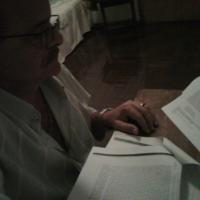Mensagens: 32
Idioma: English
bryku (Mostrar o perfil) 22 de janeiro de 2014 07:14:49
michaleo:... Let's take for example a common English word - get. According to an English-Polish dictionary it has over 30 meanings (I haven't tried to memorize all of them). During a conversation you have to decipher a meaning in a split second. Needless to say, the word is also very idiom-productive...A lifetime practice is all you need.
sudanglo (Mostrar o perfil) 22 de janeiro de 2014 11:12:08
willem44 (Mostrar o perfil) 22 de janeiro de 2014 11:43:41
I think it can be applied to Esperanto, and then one immediately sees how simple it is, compared with national languages.
sudanglo (Mostrar o perfil) 22 de janeiro de 2014 11:54:10
So Sudanglo, what would be the best way, according to you, to teach a language like Esperanto? I am curious to know.Thank you for the invitation. But I would also like to see other people's ideas as well.
Anyway here goes.
Esperanto is largely learnt by well-educated adults. They will be aware of many geographical historical, mathmatical, geographical and scientific facts as well as common everyday beliefs. Also there are many international or guessable words in Esperanto. Also people like puzzles.
Step 1
I would start with a page of such 'facts' in Esperanto with the vocabulary chosen to be recognizable, but with no limitations on the grammar used in the facts. The student's task would be to sort the facts into those that are true and those that are false. Answers in the back of the book
For example: The computer was invented by Jesus. America invaded Iraq in 2003. 1 plus 1 = 5. Water boils at 100°C, the Amazon is longer than the Nile. Paris is the capital of Germany. There are 365 days in a year. Pigs can't fly. A tiger is a bird. Einstein was born in the 16th Century and is considered to be the founder of Modern Fashion.
You could have a lot of fun with dreaming up silly facts, but you would have to grade all the 'facts' as to guessable meaning by testing them first in a population that doesn't know Esperanto.
Step 2
I would introduce the idea that in Esperanto most words require a grammatical ending but some can be used without. This is the most basic fact about Esperanto.
The student's task would be to re-read the 'facts' and to try and distinguish between words that do have a finajxo and words that don't and to list the endings.
Step 3
List Esperanto words that typically have a particular ending (using International vocabulary) and get the student to identify the function of the ending.
kaŝperanto (Mostrar o perfil) 22 de janeiro de 2014 14:48:35
sudanglo:That's a very interesting idea, but I imagine that, like anything else, it will appeal to the learning style of some and not others. Different people learn differently. For me I learn the quickest by reading (interesting) material that is far above my level, and by listening to music and audio courses (but mostly music). I'm reading the translation of Tolkien's "The Hobbit", which uses quite a lot of difficult vocabulary and complex sentence structure, or at least difficult enough that I can maybe get 5 pages an hour while constantly checking my dictionaries. Most music is also more complex in that they more poetically explore the grammatical possibilities, and I generally want to understand what I'm listening to so I analyse the lyrics.So Sudanglo, what would be the best way, according to you, to teach a language like Esperanto? I am curious to know.Thank you for the invitation. But I would also like to see other people's ideas as well.
Anyway here goes.
Esperanto is largely learnt by well-educated adults. They will be aware of many geographical historical, mathmatical, geographical and scientific facts as well as common everyday beliefs. Also there are many international or guessable words in Esperanto. Also people like puzzles.
Step 1
I would start with a page of such 'facts' in Esperanto with the vocabulary chosen to be recognizable, but with no limitations on the grammar used in the facts. The student's task would be to sort the facts into those that are true and those that are false. Answers in the back of the book
For example: The computer was invented by Jesus. America invaded Iraq in 2003. 1 plus 1 = 5. Water boils at 100°C, the Amazon is longer than the Nile. Paris is the capital of Germany. There are 365 days in a year. Pigs can't fly. A tiger is a bird. Einstein was born in the 16th Century and is considered to be the founder of Modern Fashion.
You could have a lot of fun with dreaming up silly facts, but you would have to grade all the 'facts' as to guessable meaning by testing them first in a population that doesn't know Esperanto.
Step 2
I would introduce the idea that in Esperanto most words require a grammatical ending but some can be used without. This is the most basic fact about Esperanto.
The student's task would be to re-read the 'facts' and to try and distinguish between words that do have a finajxo and words that don't and to list the endings.
Step 3
List Esperanto words that typically have a particular ending (using International vocabulary) and get the student to identify the function of the ending.
IMHO the best teaching method is to have a traditional-style course on the grammar basics with several follow-up paths to suit different tastes.
erinja (Mostrar o perfil) 22 de janeiro de 2014 15:01:08
bartlett22183 (Mostrar o perfil) 22 de janeiro de 2014 18:49:40
michaleo:Moreover, sometimes even basic communication can make difficulties. Let's take for example a common English word - get. According to an English-Polish dictionary it has over 30 meanings (I haven't tried to memorize all of them). During a conversation you have to decipher a meaning in a split second. Needless to say, the word is also very idiom-productive.Yes, with languages such as English, this phenomenon occurs. Look also at the English word fast, which can be a noun, adjective, verb, or adverb with significantly different meanings depending on context. However, supposedly, at least according to my understanding, a given root in Esperanto has only one meaning or a close cluster of meanings, a cluster which in some other languages might itself be covered by a single word. This is a major advantage of E-o, I would say. I don't have to struggle with monstrosities such as get and fast. (And many of the clusters can often be dealt with by a root and affixes.)
robbkvasnak (Mostrar o perfil) 22 de janeiro de 2014 20:50:05
As for "Saluton!" - imagine a German class in which the expression "Guten Tag!" was not mentioned sometime at the beginning of the course. And how about "Wie geht's dir?" or "Wie geht's Ihnen?" There we have a juicy dative which Esperanto doesn't have - and yet first-term German students "get it". Hehehe.
Paulinho (Mostrar o perfil) 22 de janeiro de 2014 23:56:51
sudanglo (Mostrar o perfil) 23 de janeiro de 2014 11:30:57
However, whilst my original post was somewhat of an attempt to be humorous, it does seem to me that one is missing trick in aping the design of courses in national languages in a course in Esperanto.
Esperanto is accessible for anybody who might take a fancy to learning it - we have, in any case, no organised structures for preventing particular classes of persons from learning Esperanto.
Yet it would be highly desirable to have courses attractive to the bright young things who might later in life attain positions of influence in society.
Having among our ranks, a few future presidents, or members of parliament, or famous artists to be, would be a decidedly positive thing for the future of Esperanto.
Imagine the snob value that being able to speak English has in certain countries, being applicable to Esperanto. If only the crème de la crème spoke Esperanto, who wouldn't want to learn it?







